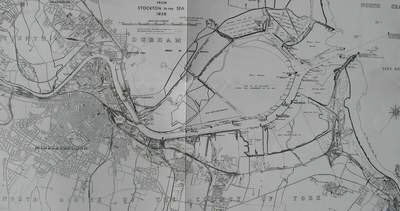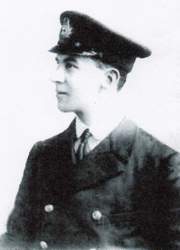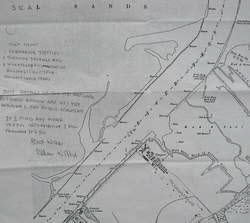Abandoned Communities ..... Teesport
On Sunday 7 October 1934 my father, Cyril Fisk, wrote in his journal that he had been to Teesport to take a service. About a month earlier he had started the first job in his career as a Methodist minister. The journal entry noted that Teesport was a former submarine base and that the houses there were all condemned. My father commented that Teesport was "the most awful show in creation".
Teesport lay on the south bank of the River Tees about three miles from the centre of Middlesbrough. It is marked on the map at the left, published in 1931. The map at the foot of the page shows the wider area, the jetties and docks along the river, and the iron and steel works that brought prosperity to Teesside in the nineteenth century.
The map below also shows another village that is now abandoned, Warrenby, near the coast between the Dorman Long iron and steel works and Coatham. Go to the Links page if you would like to know more about Warrenby.
Submarines were based at Teesport during World War I. They would have been ready to play a part in the defence of the River Tees, and in addition they would have operated in the North Sea and, later in the war, further afield. According to the information that has come to me there were six E class submarines (E21, E34, E41, E45, E46, and E51), whose main function seems to have been mine laying. In 1916 they were joined by (or possibly replaced by) the Tenth Flotilla. Commanded by Leonard A.B. Donaldson, the Tenth Flotilla comprised a depot ship, the Lucia, two E class submarines, and six G class submarines.
At the very end of World War I one of the Tenth Flotilla submarines, the G11, was briefly commanded by Lieutenant Richard Douglas Sandford, who had gained the Victoria Cross for his part in the Zeebrugge Raid in April 1918. The war came to an end on 11 November, 1918, but Sandford contracted typhoid and died on 23 November. He was buried in Eston cemetery.
The buildings at the submarine base would have included storage areas for mines and equipment, workshops, and staff accommodation. The 1931 map shows a track connecting the base with the nearest suburb, Grangetown, about two miles to the south. I assume that building materials and supplies would have been brought to Teesport along this track in carts.
Teesport lay on the south bank of the River Tees about three miles from the centre of Middlesbrough. It is marked on the map at the left, published in 1931. The map at the foot of the page shows the wider area, the jetties and docks along the river, and the iron and steel works that brought prosperity to Teesside in the nineteenth century.
The map below also shows another village that is now abandoned, Warrenby, near the coast between the Dorman Long iron and steel works and Coatham. Go to the Links page if you would like to know more about Warrenby.
Submarines were based at Teesport during World War I. They would have been ready to play a part in the defence of the River Tees, and in addition they would have operated in the North Sea and, later in the war, further afield. According to the information that has come to me there were six E class submarines (E21, E34, E41, E45, E46, and E51), whose main function seems to have been mine laying. In 1916 they were joined by (or possibly replaced by) the Tenth Flotilla. Commanded by Leonard A.B. Donaldson, the Tenth Flotilla comprised a depot ship, the Lucia, two E class submarines, and six G class submarines.
At the very end of World War I one of the Tenth Flotilla submarines, the G11, was briefly commanded by Lieutenant Richard Douglas Sandford, who had gained the Victoria Cross for his part in the Zeebrugge Raid in April 1918. The war came to an end on 11 November, 1918, but Sandford contracted typhoid and died on 23 November. He was buried in Eston cemetery.
The buildings at the submarine base would have included storage areas for mines and equipment, workshops, and staff accommodation. The 1931 map shows a track connecting the base with the nearest suburb, Grangetown, about two miles to the south. I assume that building materials and supplies would have been brought to Teesport along this track in carts.
One
Part of the River Tees in 1931.
The written notes have been added by my colleague, Allan Wilby.
An E Class submarine
The Tees estuary in 1938
HMS Lucia and the Tenth Flotilla
Richard Sandford




